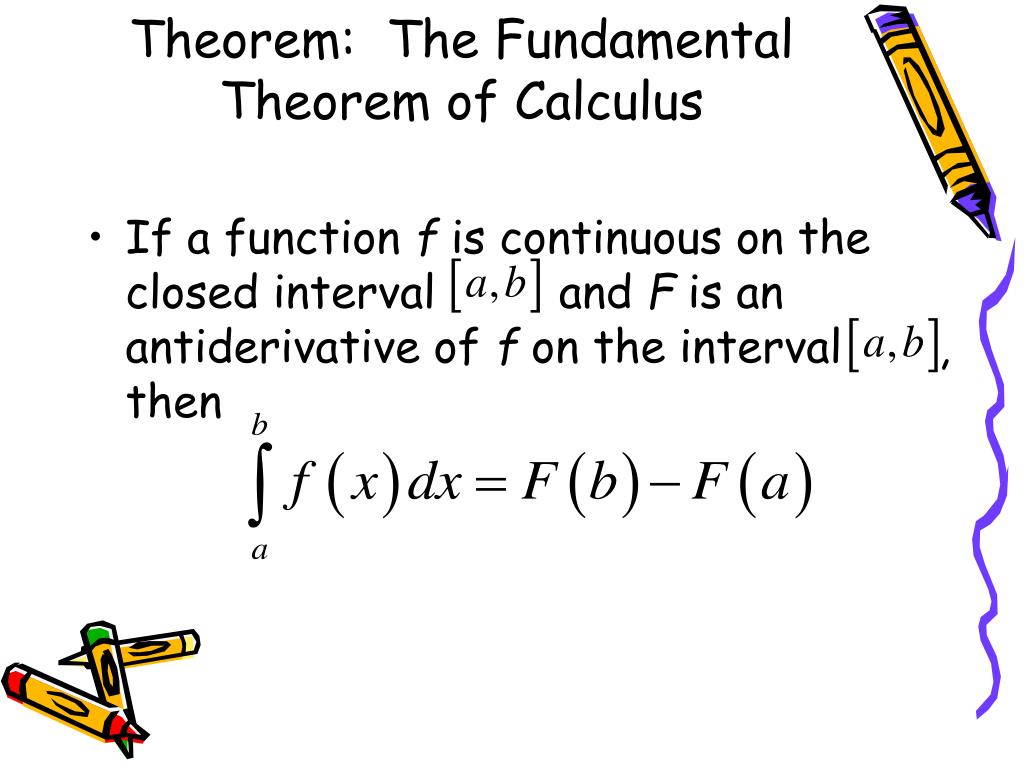

It is the area under the graph of, above the axis, and between the vertical lines at and. If for all in a closed interval, then certainly represents a true area. More broadly, definite integrals are defined to give what are sometimes called “signed” areas rather than “true” areas. That is pretty amazing! Signed Area Interpretation and Computation The area of the region under the graph of (and above the horizontal axis) between and can be found to be exactly with the FTC. This is indeed the area of the complicated region shown in the figure below. You should check, using the Product Rule and Chain Rule, that is an antiderivative of the integrand. Example 2: Find a Complicated Area with the First FTCįor instance, consider the definite integral. On the other hand, there is no guarantee that an antiderivative will be easy or even possible to find. This is a vast (infinite) extension of what you learned about areas of objects in geometry!

It tells us that finding an antiderivative is most of the way to finding what could be, quite possibly, a very complicated area. First Fundamental Theorem of Calculus: Suppose that the function is an antiderivative of the function on an interval, so that for all in, then. Statement of the First Fundamental Theorem of Calculus The version we just used is typically called the First Fundamental Theorem of Calculus. Since the limits of integration in are and, the FTC tells us that we must compute. How is this done? The FTC tells us to find an antiderivative of the integrand function and then compute an appropriate difference.Īn antiderivative of is. Note that each box has an area of, so you should be able to count just under 17 boxes total. This can be visually confirmed by counting boxes (and partial boxes) under the graph. The area of the region under the graph of (and above the horizontal axis) between and can be found with the FTC to be equal to. The region is bounded by the graph of, the -axis, and the vertical lines and. This symbol represents the area of the region shown below. Example 1: Find an Area under the Graph of the Squaring Function using the FTCįor example, consider the definite integral. If you ask a studious calculus student what the Fundamental Theorem of Calculus is, what will they answer? In all likelihood, that student will tell you that it gives a method to evaluate definite integrals.įor a function whose graph is always above the horizontal axis, it therefore gives you a way to find the area under its graph and above the axis. īut what is the FTC (both parts)? And why is it true? Let’s explore! The First Fundamental Theorem of Calculus The notation is understood to mean, just as means. This is equation is typically written as, where and are suitably nice functions.

On the other hand, in my third post, “Integration by Parts (and Linear Motion)”, it is the Product Rule that must be combined with the FTC to obtain the key equation. The FTC along with the Chain Rule are the facts that are necessary to prove this. The key definite integral equation that is derived there, assuming we have appropriately nice functions and, is. In my second post, “Integration by Substitution (Method of Integration)”, I discuss how the FTC is relevant to the substitution method. This is natural to do for a second semester calculus course, because the FTC is usually introduced in the first semester.
Second fundamental theorem of calculus practice problems series#
In my current series of blog posts based on my Calculus 2 lectures at Bethel University from the Fall 2016 semester, I have already been making use of the FTC. These forms are typically called the “First Fundamental Theorem of Calculus” and the “Second Fundamental Theorem of Calculus”, but they are essentially two sides of the same coin, which we can just call the “Fundamental Theorem of Calculus”, or even just “FTC”, for short. The Fundamental Theorem of Calculus is often split into two forms in textbooks.


 0 kommentar(er)
0 kommentar(er)
